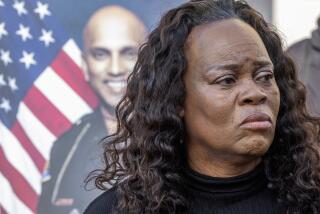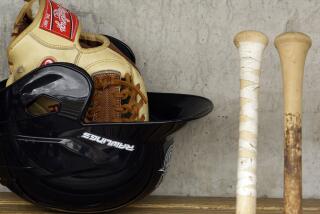Pasadena, Nov. 28, 1900: Just Another Perfect Day
Nothing brings the past to life like an old newspaper. The stories may seem quaint, by today’s standards, but they have the immediacy of news.
Burt Henderson of Ventura sends me a copy of the Pasadena Evening Star for Nov. 28, 1900--only 34 days before the turn of the century. He found it among his mother’s papers. He has no idea why she saved it.
At the turn of the century Pasadena was the new Eden. There was no television to paint its balmy New Year’s days in the parlors of the frozen Middle West, but its residents described its amenities in streams of letters to snowbound relatives.
The Star of that day took immodest notice of the Crown City’s advantages, eulogizing it as “beautiful, stately and progressive” and pointing out that it was only 18 miles from the ocean, “as the crow flies,” protected on three sides by lofty mountains and open to sea breezes from the southwest.
Alas, Pasadena today still enjoys the protection of those mountains, but the breezes from the southwest are more likely to be laden with smog than with the refreshing scents of the sea.
Evidently this was a special Thanksgiving section, so it tends to be expansive about the rewards of life in Pasadena and short on the gritty news of the street that must have marred the serenity of the landscape even in that day.
It makes a point of the city’s youth, recalling that only 25 years before it had been an open stock range. In 1873 the Indiana Co. had bought 4,000 acres and incorporated as the San Gabriel Orange Grove Assn. The first frame cottage was built in 1876.
“Pasadena, as a city,” the article continued, “is both moral and aesthetic. It has no licensed saloon, and is a center of art, education, Christian advancement and refinement.”
Transportation was state-of-the-art. “An electric car line, three railroads, and an elevated cycleway make the nine miles’ travel to Los Angeles fast and pleasurable.” Today’s commuter, creeping along the Pasadena Freeway at rush hour, might well envy his great-grandparents their choices.
The ads tell us much about life in 1900. Oddly, the first ad at the top of the page shows an Adonis in a suit of long underwear, and advises, “When the moist days come, have a dry change of woolen underwear.” Prices, for men, began at $1. Evidently old habits died hard. I doubt that a suit of long woolen underwear could be found on any man in Pasadena today.
An 80-by-200-foot lot on Euclid Avenue near Center Street was advertised for $1,100. Wallace Brothers, 16 S. Raymond Ave., advertised “a large amount of money” to be loaned at 5 1/2%. A five-room house on Fair Oaks Avenue was for rent for $8.
The Casa Palma, in Riverside, offered rooms in “the Orange Metropolis of the World” for $2 to $3.50 a day, American plan, 75 cents to $2, European plan. The Banning Co. offered round-trip steamer trips to Catalina Island for $2.95, with connecting trains from Pasadena to San Pedro.
The Mt. Lowe Railway offered its scenic Mt. Lowe ride from Altadena for $1.50 round trip (Thanksgiving special) with lunch or dinner served at Ye Alpine Tavern, 75 cents.
Throop Polytechnic Institute and Manual Training School, forerunner of today’s Caltech, offered “complete courses in sewing and cooking” as well as biological, physical, chemical and electrical laboratories. Tuition: $75 a year.
In a column called “The Cost of Living,” one C. C. Cleghorn assured friends in the East that it was possible to live well on 30 cents a day in Pasadena, if one simply excluded meat from his diet. He recommended grains such as Granola and Grape Nuts, nuts, apples, bread (5 cents a loaf) and vegetables in season. “Considering that we have fresh vegetables of some kind grown outdoors every month of the year, one can see that the chance for a variety in diet is much greater than in the East.”
While conceding that “it is not the province of a secular journal to set up a standard of Christian morals,” the Star nonetheless commented editorially that Thanksgiving was a Christian holiday and that participating in sports was unseemly. “The propriety of the sports sometimes indulged in on Thanksgiving is seriously to be questioned. . . .”
The Weather Forecast was simple: “Fair tonight and tomorrow.”
More to Read
Sign up for The Wild
We’ll help you find the best places to hike, bike and run, as well as the perfect silent spots for meditation and yoga.
You may occasionally receive promotional content from the Los Angeles Times.






